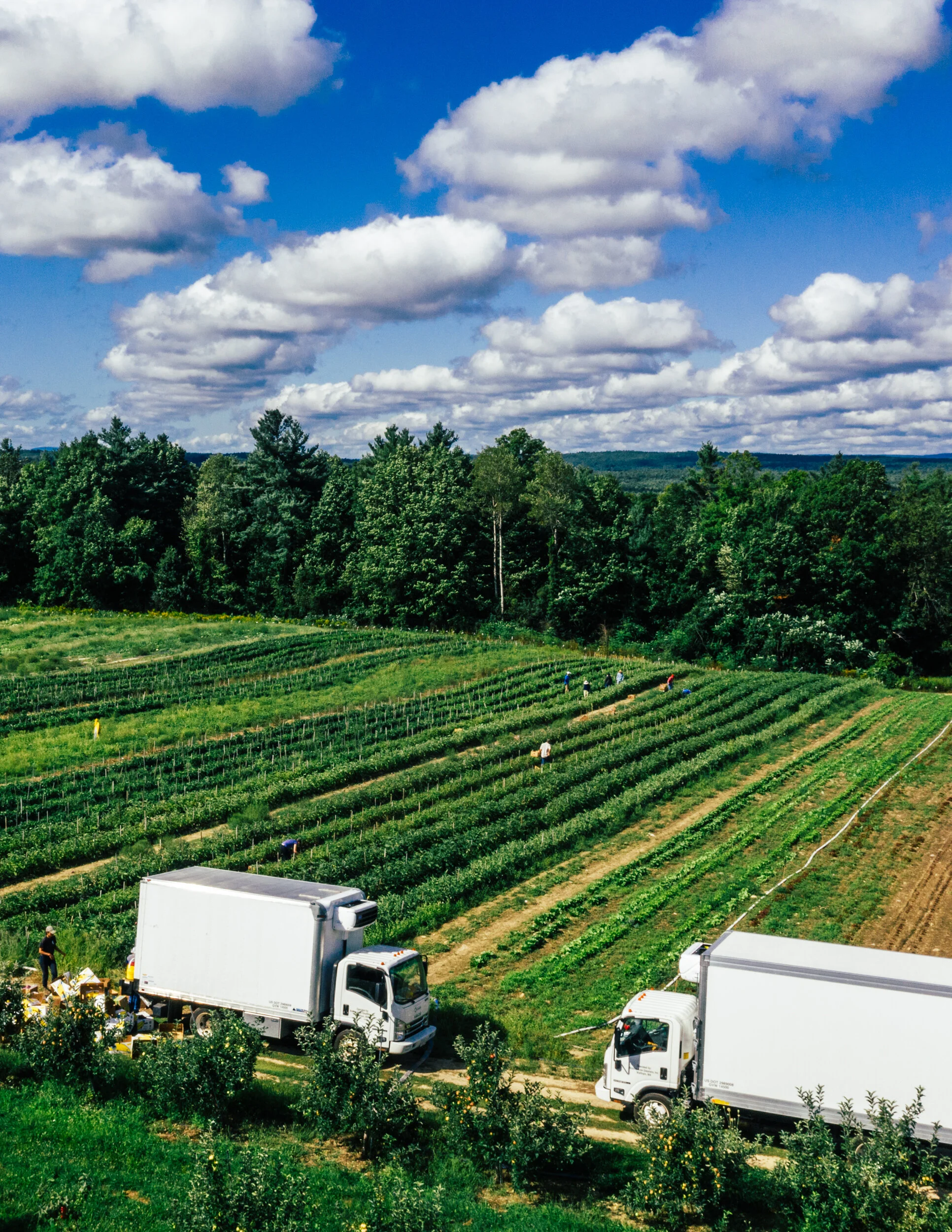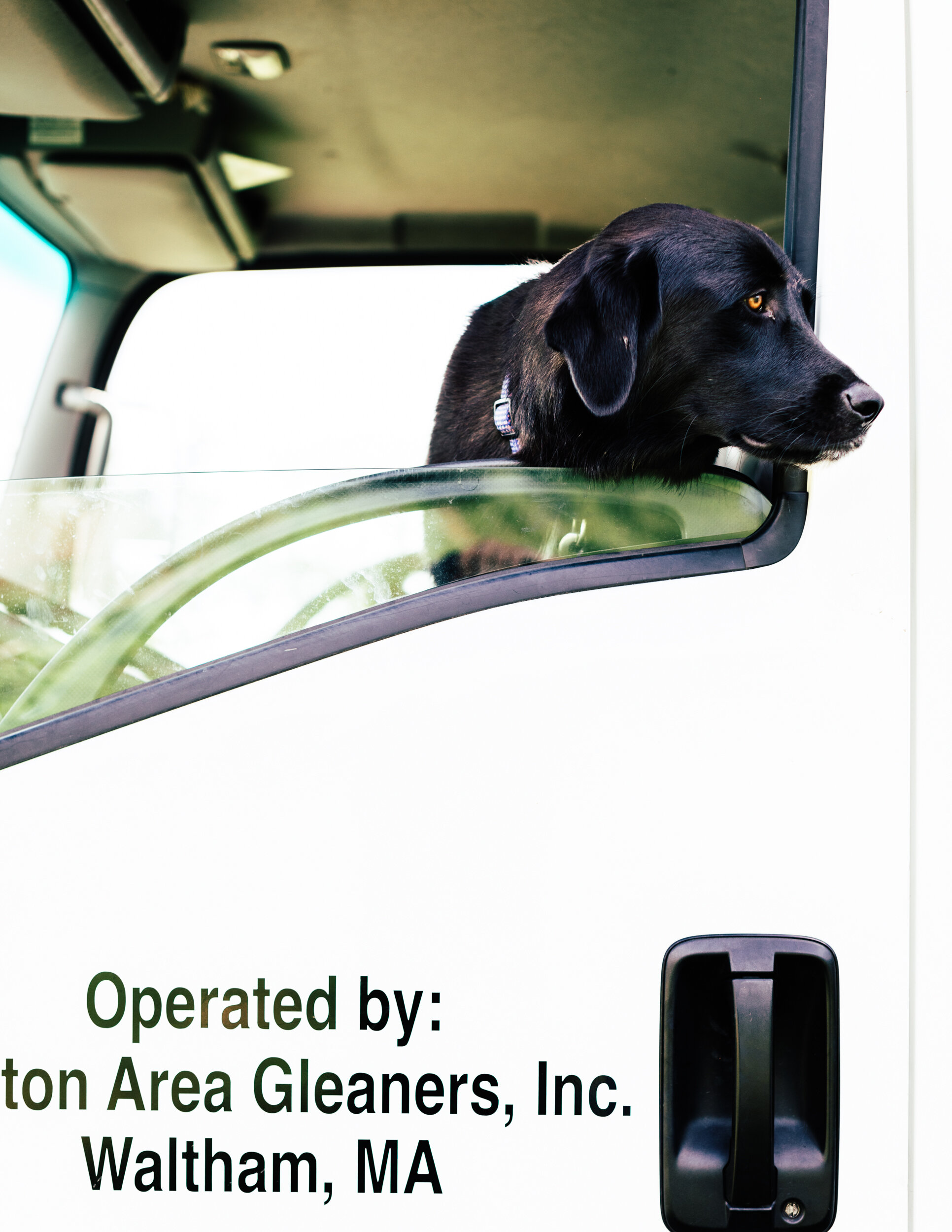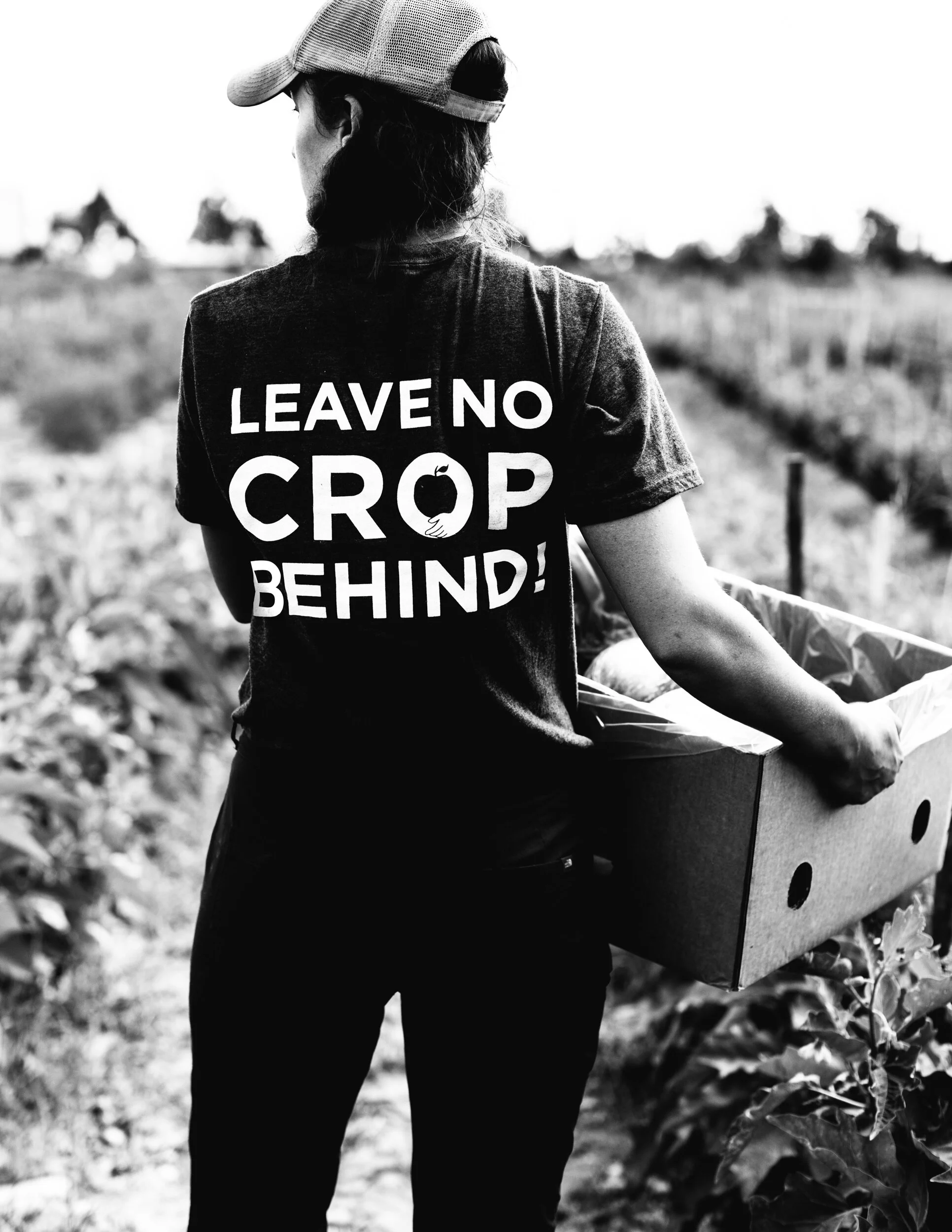The Boston Area Gleaners
Photos by Michael Piazza
Eighteen volunteers showed up on one sunny mid-summer Saturday morning to harvest kale at Siena Farms. The trip to Sudbury was scheduled by the Boston Area Gleaners. Operations Team Leader Leah Costlow demonstrated how to cut and snap the thick stalks with a knife and offered safety guidelines, which include watching out for tripping hazards like rocks, weeds and stalk stubs protruding from the ground. The volunteers donned work gloves, wandered into the planted rows and began to cut bunches of kale. As instructed, the gleaners placed the greens in plastic-lined banana boxes. When each box was tightly packed, weighing about 12 pounds, a staff member carried it to one of the waiting trucks. By the end of the day, the group filled 213 cases, yielding 10,000 servings of curly and Lacinato kale.
“Gleaning” is harvesting surplus crops from farmers’ fields. Its purpose is to take nutritious food that would otherwise go to waste and provide it to people in need. The ages-old practice is referenced in the Bible: And when you reap the harvest of your land, you shall not wholly reap the corners of your field, neither shall you gather the gleaning of your harvest; you shall leave them for the poor, and for the stranger. (Leviticus 23:22)
Today, food rescue—whether it’s from farms, supermarkets, wholesalers, corporate dining facilities or restaurants— has become critically important due to the double whammy of excessive food waste and increasing food insecurity. The statistics are dire: An estimated 30% to 40% of the food supply in the United States is wasted. At the same time, one in eight Americans is food insecure; that’s about 40 million Americans, including more than 12 million children.
That so much edible food is discarded while people are struggling to put nutritious meals on their tables makes the roughly 130 billion pounds and $160 billion of annual food waste unconscionable. Also wasted are the resources it took to produce all that food, including water, labor, land, energy and other inputs. And most discarded food ends up in landfills; its decay is one of the major sources of methane, a powerful greenhouse gas.
Gleaning, typically arranged at local levels, is a quadruple win-win. It accomplishes the enormously worthy goals of reducing on-farm food waste, getting fresh produce to those who need it, helping farmers make their crops accessible to more people and reducing the effect landfills have on the environment.
The Boston Area Gleaners started in 2004 with a vision (and mission) by environmental and gleaning advocate Oakes Plimpton. The organization adopted a more formal focus in 2010 under the direction of Laurie “Duck” Caldwell. To date, BAG has gleaned over 2.7 million pounds of high-quality produce.
Operations Manager Charlotte Border explains BAG’s role in the distribution chain: “We’re an aggregator; we’re not serving the end consumer, but we’re facilitating the distribution of produce to the agencies who know the community the best and can serve it the best.” Beneficiary organizations include the food banks in Boston, Worcester, Merrimack Valley, New Hampshire and Rhode Island and over 40 food pantries, community kitchens and meal programs, as well as distribution partners which help deliver produce to hunger relief agencies.
One of the volunteers at Siena Farms was Kathleen Kelly of Quincy, who has gleaned with BAG for three years. “I’ve hoed potatoes, picked apples and peas, beans and scallions, and now kale,” she says. Spending many years working with homeless families and the elderly, she knows how much people in shelters appreciate fresh fruits and vegetables.
With BAG’s indomitable get-out-and-get-it spirit, Border says, “As long as we have the time and labor, we want to take everything we’re offered from farmers. During the busiest months of September, October and November, we’ll do 30 gleans a week.” In 2018, with the help of around 700 volunteers (over 4,000 volunteer hours), BAG gleaned a whopping 819,000 pounds of food, yielding 3.2 million servings of fresh produce. The largest hauls were apples, winter squash, corn, root vegetables, greens and stone fruits. Its 2019 goal is to capture one million pounds.
Boston Area Gleaners is funded mostly by foundations, corporate gifts and individual donations, as well as some earned income from partnership service fees. Expenses are primarily for staff (currently 10 people), equipment, rent, supplies and miscellaneous services. “We couldn’t do it without our volunteers,” says Dylan Frazier, director of operations.
Volunteer gleaners come from all walks of life; many are recently retired and all enjoy being outdoors and giving back. On the kale harvesting trip, Sally Thompson of Acton, a retired physician, says she started gleaning a few years ago. “As a new retiree, I was looking for a way to keep being helpful. This appealed to me especially because I grew up on a farm in New Jersey.”
Judy Nathans of Cambridge, a six-year volunteer, won Gleaner of the Year in 2018 by making the most gleaning trips (39). “Food rescue has become my passion for the last few years,” she says. Ellen Kisslinger of Hudson enjoys the sense of community and also “making a difference in people’s access to food, particularly produce.” Kisslinger cooks once a month for community dinners at the First Parish Church of Stow & Acton.
Newcomer Colton Sullivan of Bedford likes the change of pace from his desk job at Hanscom Air Force Base. “I love being outside and I love the cause,” he says. “Everyone’s been so friendly so far, it’s going to keep me coming back.”
For Newton’s Jeanie Gruber, owner of Miss Jeanies Catering, the process is almost meditative. “It’s peaceful,” she says “I love being out amongst the vegetables.” The Louisiana native adds that BAG is “the most pure organization I’ve been around.”
So where does the bounty come from? BAG partners with over 50 farms each year, working with those that have surplus crops available. The farmers’ motives generally boil down to economics and goodwill.
Chris Kurth, owner of Siena Farms and the aforementioned kale field, says that “because we participate in the local food system, part of our mission is to provide food to a wide variety of customers. The gleaners connect the dots on that opportunity to get the produce to people who need it.”
In agriculture, having either surplus or gaps in crops is inevitable, caused by over- or underestimating needs, the vagaries of market demand, weather, pests and more. When customer demand isn’t there, as with Kurth’s excess kale, allowing the gleaners to harvest it makes good sense. “It’s hard to justify the labor costs of picking a crop and not selling it,” he says.
Sometimes it’s a quality issue. Kurth says, “If the quality of the crop is below a certain standard, we don’t want to present it to our customers,” which for Siena Farms are its CSA members, restaurants and the farm’s retail outlets. “The kale is perfectly good food to eat, but not to sell to customers,” he says.
Without the gleaners, says the Sudbury farmer, “we simply would have harrowed it in, leaves and all.” Plowing remaining crops back into the soil adds nutrients, but the food is wasted. Kurth estimates that 20% of the food value of his crops is never harvested.
For Carl Hills, co-owner with his wife, Marie, of Kimball Fruit Farm in Pepperell, bringing in the gleaners is a financial decision. As a retail grower (selling directly to consumers at his farm stand and 10 farmers markets), if production outweighs retail demand and it’s not cost-efficient to harvest the crop, he says, “I’m not going to wholesale it. I’m going to call the gleaners. I have Dylan on speed dial.”
As BAG has grown and become more effective at what it does, Hills says, “They make it easy for us. One year they took over 35 tons off my farm. It makes me feel good knowing [the food is] being distributed by a well-oiled organization.”
Scheduling over 400 gleans during the growing season is an operational challenge. “All crops are perishable so it’s time sensitive when we can get in there,” says Frazier. They’re also hampered by limited resources. “We try to maximize our infrastructure and ability,” he says. “If we had more trucks and more staff we could get more produce. Because there’s always more need.”
What might be surprising is that the gleaners’ goal isn’t to take everything in the field. They can be choosy. “There’s so much, we can’t get everything,” says Frazier. “We just take the best. It’s farmers-market quality. We call it food with dignity.”
The area’s hunger relief agencies are delighted to have fresh produce to offer their clients. BAGs Interim Executive Director Usha Thakrar, who started working with the organization this summer, has volunteered at the Lexington Food Pantry for over five years. “In the winter months we are limited to what we can purchase, but in the summer and fall, thanks to BAG and a couple of local farms, we are able to offer our clients an abundance of choices,” she says. “This is particularly important for our families with children.”
For something as simple and seemingly mundane, gleaning to benefit so many people is rare and wonderful. And the gleaners themselves feel good about doing good. Thompson, the retired physician, says, “I feel as though I do more good as a gleaner than I did as a doctor. Providing nutritious food to people in need is a real public health measure.”
This story appeared in the Fall 2019 issue.










